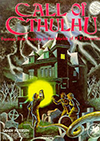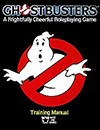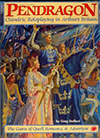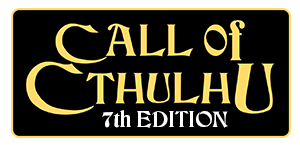100 Best Games - Call of Cthulhu
Just click on the game cover to read the related essay

Call of Cthulhu - Monte Cook
Key Designer: Sandy Petersen
Chaosium (first edition, 1981)
Since the early days of the hobby, if you were to ask virtually any roleplayer what other game should be on the ideal RPG shelf (other than the ubiquitous Dungeons & Dragons), it’s likely the answer would be Call of Cthulhu. As a counterpoint to the games that preceded it, and the vast majority of those that came later, this horror game does not stress character improvement and gaining wealth or power. Instead — like the mythos created by H.P. Lovecraft, the writer upon whose works the game is based — this dark game thrives upon madness, deterioration, and even character death. And yet, because of these things, not despite them, the game has cemented itself as one of the most enjoyable play experiences in the hobby.
Howard Phillips Lovecraft’s relatively small body of work has been extraordinarily influential on 20th- and 21st-century horror and fantasy. Virtually every tentacled beastie that rears a bulbous eye from the murky brine owes at least a nod of gratitude to Lovecraft and his most famous creation, the monstrous Cthulhu. Although not without their literary flaws, Lovecraft’s stories evoke a unique mood of nihilistic gloom — a horror that comes as a gradual realization of the truth rather than as a sudden shock. They present us with a world where man does not even begin to comprehend the true nature of his universe, and he’s the better for it. Lovecraft’s horrors are vast, unknowable beings that as likely as not possess no more awareness of us than a man is aware of the anthill he accidentally crushes as he walks to work. Still, as groundbreaking as these stories were, it is sometimes surprising that they, published in disposable pulp magazines such as Weird Tales, managed to survive the irresistible pull toward the pit of obscurity that has consumed the work of so many of Lovecraft’s contemporaries from the 1920s and 1930s. In fact, it is likely that the roleplaying game itself has become the major contributor to Lovecraft’s enduring popularity, introducing new generations to his dark visions of cosmic horror.
Game designer Sandy Petersen was a fan of Lovecraft’s work and imagined a means to capture the mood of his most famous stories. The result of his labors was the first horror roleplaying game, creating a legacy which would influence hundreds of designers after him. The game has gone on to become Chaosium’s flagship product, selling hundreds of thousands of copies in its various editions.
Lovecraft’s tales are set primarily in the 1920s, and thus so is the game (although, eventually, the game spread to other eras). Call of Cthulhu turns the traditional power fantasies found in RPGs — where characters attain godlike might, rule entire kingdoms, and slay dragons with a single stroke of a sword — on their collective ears. Characters are designed to get worse as time goes on, not better. Things that make characters more powerful in the game, such as books of forbidden spells or the amassing of lore about the dark secrets of the universe (in the form of a skill simply called Cthulhu Mythos) carry with them great dangers. In fact, these items and skills almost always end up spelling an early end for the characters who utilize them.
Mechanically, Call of Cthulhu is deceptively simple. The game uses a percentile-based system taken from Chaosium’s Basic Role-Playing — itself a simplified version of their RuneQuest game — for most task resolution, integrating combat and non-combat skills in a cohesive framework. Rather than the hulking warriors, mighty wizards, roguish starship captains, and masked superheroes of other games, Call of Cthulhu characters are fragile things. Many are not just average folk, but are in fact bookish professors and bespectacled investigators with extensive knowledge of history, archeology, and obscure languages, but rarely any grounding in combat or survival skills.
The true genius of the game’s mechanics, however, lies in its handling of sanity. Each character has a sanity score (or SAN), like hit points. This same score is the number you must roll under to avoid losing more points when witnessing terrible events and encountering supernatural entities. However, as one loses SAN, this roll becomes more difficult, which means one quickly loses more SAN, which, of course, means that the roll becomes still more difficult, and so on — a so-called “sanity death spiral.”
The game’s continued appeal owes as much to the self-effacing dark humor of the devoted players as it does to game mechanics. While the gameplay itself is deadly serious, when people talk about the game they typically tell you about their characters’ deaths and bouts of insanity with a manic glee rarely seen in other play experiences. It’s become a sort of rite of passage among gamers to have some ululating eldritch horror tear their character apart in a grisly way or drive them insane, so that they race about, cavorting madly, while the world ends or sit catatonic while the eldritch horror devours their comrades.
For many people, Call of Cthulhu is the perfect “alternative” game. In between longer campaigns of other, more traditional RPGs, they enjoy a “one-shot” Call of Cthulhu game as a break. These usually play out like a single horror story or movie. The characters are normal people who come upon something extraordinary and then try to escape with lives and sanity intact. No matter what the group’s regular game, Call of Cthulhu is almost certainly a change of pace, one that encourages a different play style because the characters are likely doomed to short, unpleasant lives. Players need not feel attached to their characters and can revel in, rather than rue, their demise. This brief, but intense style of play also lends itself well to games run at conventions, which is likely another contributor to the game’s enduring success.
Ironically, though, Call of Cthulhu’s supplements include some of the best campaign-length adventures ever published, for any game, in particular the excellent Masks of Nyarlathotep by Larry DiTillio, Lynn Willis, and others. The dedicated Call of Cthulhu player appreciates campaigns as much, or more, than short adventures, but they are notoriously difficult to create, since the horror must be revealed slowly. In Masks of Nyarlathotep, like many archetypal Call of Cthulhu campaigns, the heroes begin by investigating the possibly mundane plots of mad cultists, only to encounter more and more of the unexplainable — Omar Shakti, a sorcerer who casts real spells; then monsters such as zombies and fire vampires; and eventually an avatar of the dread Outer God, Nyarlathotep — until they can no longer deny that what they face is supernatural in origin and entirely antithetical to humanity. They cannot hope to best it, only stave it off. But in Call of Cthulhu, even these small victories are enough.
Over the years, various versions of the game have been published, setting the action in different eras but maintaining the same atmosphere of cosmic horror. Publishers beside Chaosium have produced licensed, compatible material for the game, most notably Pagan Publishing. In 2001, when given the opportunity to show off their new open game license by converting another game to the d20 System, Dungeons & Dragons publisher Wizards of the Coast chose Call of Cthulhu. Call of Cthulhu d20, for which I served as lead designer, was created as a bridge product to give D&D players a taste of this very different setting and style of play.
In the end, however, it is the original version of the game that belongs on any list of the top hobby games of all time. Having broken new gaming ground when it first emerged, Call of Cthulhu still shines brightest when cleaving as closely to Lovecraft’s own stories as possible, with Jazz Age investigators facing weird horrors they can never entirely understand, let alone defeat. In the face of such darkness, the best stories are created and players have the most fun.
Over his thirty-year career, Monte Cook has written hundreds of roleplaying game products, along with numerous short stories, novels, nonfiction titles, and comic books. He has worked full-time at Iron Crown Enterprises, TSR, Wizards of the Coast, and his own design studio, Malhavoc Press, and is probably best known for his work on such notable titles as Planescape, Ptolus, the third edition of Dungeons & Dragons (which he co-designed with Jonathan Tweet and Skip Williams), Arcana Evolved, and of course Numenera, the Cypher System, and Invisible Sun. He also designed the acclaimed miniatures game HeroClix. Monte attended the Clarion Science Fiction and Fantasy Writer’s Workshop, the NASA-sponsored Launchpad Workshop, and was inducted into the Hall of Fame of the Academy of Adventure Gaming Arts and Design. He currently works as Creative Director of Monte Cook Games. You can find out more at www.montecookgames.com.
Essay © copyright 2007, 2019 Monte Cook. Originally published in Hobby Games: The 100 Best, edited by James Lowder, Green Ronin, 2007. Reprinted by permission of the author.





